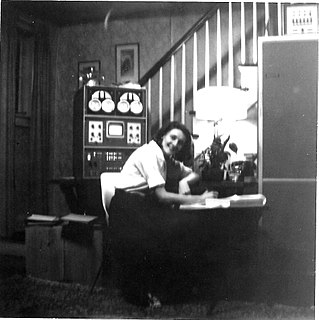
The history of computing hardware covers the developments from early simple devices to aid calculation to modern day computers. Before the 20th century, most calculations were done by humans. Early mechanical tools to help humans with digital calculations, like the abacus, were referred to as calculating machines or calculators. The machine operator was called the computer.

The LINC is a 12-bit, 2048-word transistorized computer. The LINC is considered by some the first minicomputer and a forerunner to the personal computer. Originally named the "Linc", suggesting the project's origins at MIT's Lincoln Laboratory, it was renamed LINC after the project moved from the Lincoln Laboratory. The LINC was designed by Wesley A. Clark and Charles Molnar.

The TX-0, for Transistorized Experimental computer zero, but affectionately referred to as tixo, was an early fully transistorized computer and contained a then-huge 64K of 18-bit words of magnetic-core memory. Construction of the TX-0 began in 1955 and ended in 1956. It was used continually through the 1960s at MIT. The TX-0 incorporated around 3,600 Philco high-frequency surface-barrier transistors, the first transistor suitable for high-speed computers. The TX-0 and its direct descendant, the original PDP-1, were platforms for pioneering computer research and the development of what would later be called computer "hacker" culture.

The Apollo Guidance Computer (AGC) is a digital computer produced for the Apollo program that was installed on board each Apollo command module (CM) and Apollo Lunar Module (LM). The AGC provided computation and electronic interfaces for guidance, navigation, and control of the spacecraft.
Eldon Hall was the leader of hardware design efforts for the Apollo Guidance Computer (AGC) at MIT, and advocated the use of integrated circuits for this task. He has written extensively of the development of the AGC, culminating in his 1996 book, Journey to the Moon: The History of the Apollo Guidance Computer (ISBN 1-56347-185-X)
A guidance system is a virtual or physical device, or a group of devices implementing a controlling the movement of a ship, aircraft, missile, rocket, satellite, or any other moving object. Guidance is the process of calculating the changes in position, velocity, altitude, and/or rotation rates of a moving object required to follow a certain trajectory and/or altitude profile based on information about the object's state of motion.
Draper Laboratory is an American non-profit research and development organization, headquartered in Cambridge, Massachusetts; its official name is The Charles Stark Draper Laboratory, Inc. The laboratory specializes in the design, development, and deployment of advanced technology solutions to problems in national security, space exploration, health care and energy.
Charles Stark "Doc" Draper was an American scientist and engineer, known as the "father of inertial navigation". He was the founder and director of the Massachusetts Institute of Technology's Instrumentation Laboratory, later renamed the Charles Stark Draper Laboratory, which made the Apollo Moon landings possible through the Apollo Guidance Computer it designed for NASA.

Core rope memory is a form of read-only memory (ROM) for computers, first used in the 1960s by early NASA Mars space probes and then in the Apollo Guidance Computer (AGC) and programmed by the Massachusetts Institute of Technology (MIT) Instrumentation Lab and built by Raytheon.

The Apollo primary guidance, navigation, and control system was a self-contained inertial guidance system that allowed Apollo spacecraft to carry out their missions when communications with Earth were interrupted, either as expected, when the spacecraft were behind the Moon, or in case of a communications failure. The Apollo command module (CM) and lunar module (LM), were each equipped with a version of PGNCS. PGNCS, and specifically its computer, were also the command center for all system inputs from the LM, including the alignment optical telescope, the radar system, the manual translation and rotation device inputs by the astronauts as well as other inputs from the LM systems.

The Launch Vehicle Digital Computer (LVDC) was a computer that provided the autopilot for the Saturn V rocket from launch to Earth orbit insertion. Designed and manufactured by IBM's Electronics Systems Center in Owego, New York, it was one of the major components of the Instrument Unit, fitted to the S-IVB stage of the Saturn V and Saturn IB rockets. The LVDC also supported pre- and post-launch checkout of the Saturn hardware. It was used in conjunction with the Launch Vehicle Data Adaptor (LVDA) which performed signal conditioning from the sensor inputs to the computer from the launch vehicle.

John Royer "Jack" Garman was a computer engineer, former senior NASA executive and noted key figure of the Apollo 11 lunar landing. As a young specialist on duty during the final descent stage on 20 July 1969 he dealt with a series of computer alarms which could have caused the mission to be aborted.

A transistor computer, now often called a second-generation computer, is a computer which uses discrete transistors instead of vacuum tubes. The first generation of electronic computers used vacuum tubes, which generated large amounts of heat, were bulky and unreliable. A second-generation computer, through the late 1950s and 1960s featured circuit boards filled with individual transistors and magnetic core memory. These machines remained the mainstream design into the late 1960s, when integrated circuits started appearing and led to the third-generation computer.

Donald Jesse Atwood Jr. was appointed Deputy Secretary of Defense for U.S. President George H. W. Bush in 1989. Atwood wrote the proposal and directed the organization that developed and built the Apollo guidance system.
Albert Gordon Hill (1910-1996) was a physicist. He was a key leader in the development of radar in World War II, director of the MIT Lincoln Laboratory development of the electronic Distant Early Warning and SAGE continental air defense systems, and first chairman of The Charles Stark Draper Laboratory. He died in 1996.
J. Halcombe "Hal" Laning Jr. was a Massachusetts Institute of Technology computer pioneer who in 1952 invented an algebraic compiler called George that ran on the MIT Whirlwind, the first real-time computer. Laning designed George to be an easier-to-use alternative to assembly language for entering mathematical equations into a computer. He later became a key contributor to the 1960s race to the moon, with pioneering work on space-based guidance systems for the Apollo moon missions. From 1955 to 1980, he was deputy associate director of the MIT Instrumentation Laboratory.

An inertial navigation system (INS) is a navigation device that uses a computer, motion sensors (accelerometers) and rotation sensors (gyroscopes) to continuously calculate by dead reckoning the position, the orientation, and the velocity of a moving object without the need for external references. Often the inertial sensors are supplemented by a barometric altimeter and sometimes by magnetic sensors (magnetometers) and/or speed measuring devices. INSs are used on mobile robots and on vehicles such as ships, aircraft, submarines, guided missiles, and spacecraft. Other terms used to refer to inertial navigation systems or closely related devices include inertial guidance system, inertial instrument, inertial measurement unit (IMU) and many other variations. Older INS systems generally used an inertial platform as their mounting point to the vehicle and the terms are sometimes considered synonymous.

Margaret Heafield Hamilton is an American computer scientist, systems engineer, and business owner. She was director of the Software Engineering Division of the MIT Instrumentation Laboratory, which developed on-board flight software for NASA's Apollo program. She later founded two software companies—Higher Order Software in 1976 and Hamilton Technologies in 1986, both in Cambridge, Massachusetts.
Richard "Dick" Horace Battin was an American engineer, applied mathematician and educator who led the design of the Apollo guidance computer during the Apollo missions during the 1960s.
Don Eyles is a retired computer engineer who worked on the computer systems in the Apollo Lunar Module vehicle. As a young engineer during the lunar landing on Lunar Module Eagle on 20 July 1969 he assisted with a series of computer alarms caused by data overflow from the radar, which could have caused the mission to be aborted.











